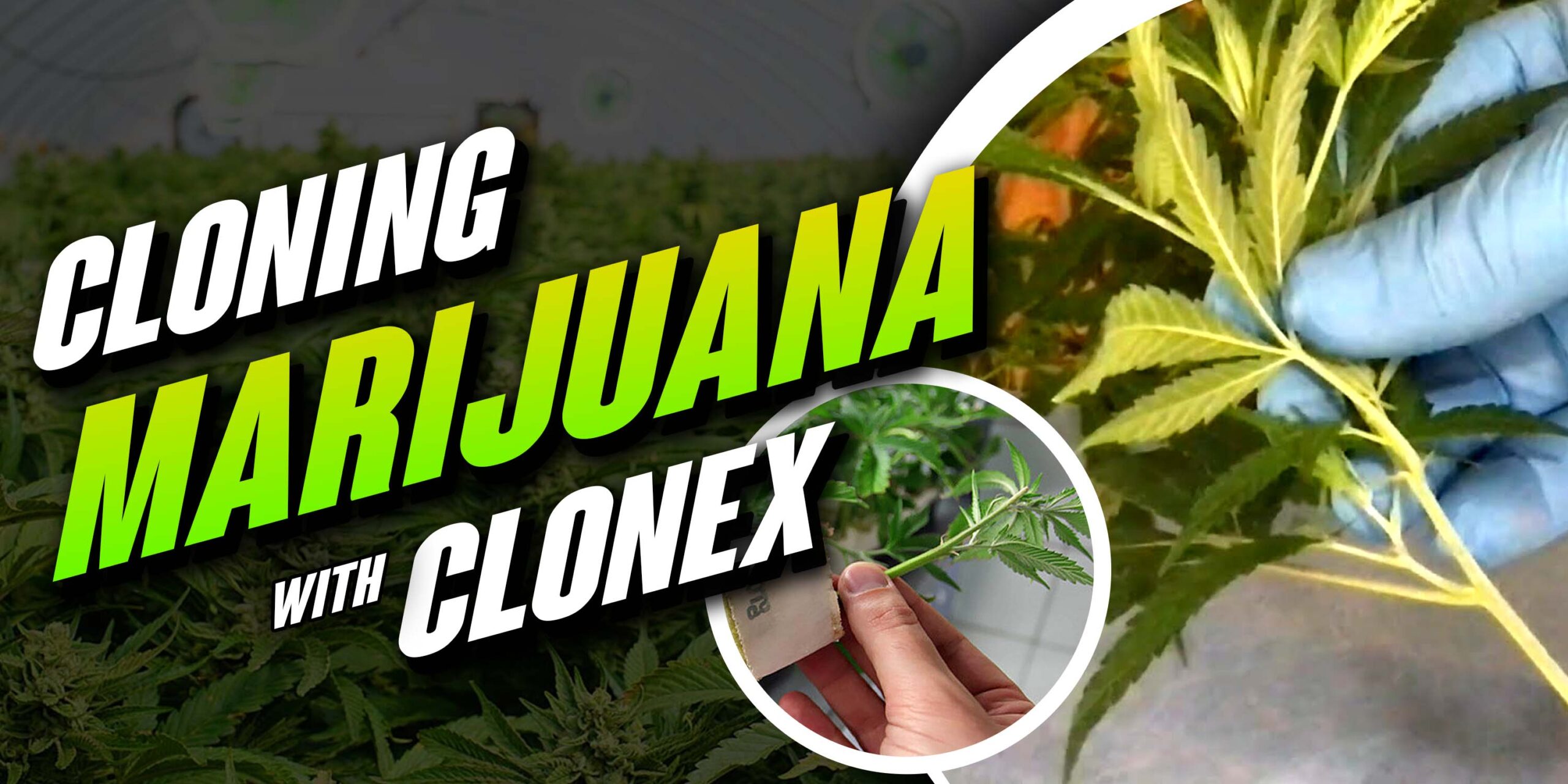Table of Contents

Table of Contents
Before you start the cloning process, it’s crucial to focus on keeping the mother plant healthy. Giving it enough clean water, balanced in pH, at least 24 hours before taking cuttings sets the stage for strong clones. This hydration step before cloning doesn’t just make sure the mother plant stays healthy overall, but it also helps in producing strong and lively cuttings.
Setting up the right workspace is more than just a practical need; it’s a crucial part of making cloning successful. Dipping peat moss plugs in water and carefully arranging them in trays creates the perfect surroundings for your clones. At the same time, getting a shot glass ready with a good amount of Clonex rooting hormone gel is the key to making the cloning process smooth and effective.
The initial step in cloning is picking out a top-notch mother plant. The best candidates show strong health, vigor, and lush leaves. It’s ideal to go for a plant from the first generation (seed) because the farther you get from the first generation, the more the genetic quality can be affected. Concentrate on selecting smaller branches near the bottom of the plant to ensure not just great cuttings but also to enhance airflow under the canopy.
After finding the perfect mother plant, the next step is the precise task of taking cuttings. Accuracy is crucial here; cutting the stem at an angle of 45-60 degrees maximizes the area for applying rooting hormone. Trimming the stem below the node is a must to ensure that when the clone is placed into its plug, it stands tall enough to compete for sunlight with other clones. Choosing to take both large and small cuttings is a strategic move, allowing for a varied approach that considers different success rates based on size.
With the cuttings ready, the focus shifts to planting. Each cutting gets a generous dip into the Clonex-filled shot glass. This step is crucial because the rooting gel gives the hormones needed to kickstart root growth. Putting the treated cuttings into pre-soaked peat moss plugs creates the right environment for roots to develop. The intentional use of plenty of Clonex in this stage increases the chances of successfully growing new plants.
After planting, the waiting game begins. Picking the right spot, whether it’s indoors or outdoors, is crucial. If growing indoors, make sure to position the light above to give the clones the light they need. A careful watering approach, filling the tray only up to a quarter and misting the inside of the dome, creates the best conditions for initial growth. Checking the clones daily for a week and keeping an eye out for signs of root growth sets the stage for the next step – transplanting.
Once you see visible signs of roots, it’s time to transplant the clones. You can choose slightly larger pots or go straight to their permanent ones. This crucial step ensures that the clones have enough room to thrive and keep growing. Keeping a close eye on them and giving them care after transplanting is important as they get used to their new home. Adjusting watering schedules and providing the right nutrients are key to the long-term success of your cloned marijuana plants.
In summary, cloning marijuana with Clonex involves careful steps, starting from picking the right mother plant to the post-transplanting phase. By following these guidelines, you not only ensure successful growth but also lay the groundwork for a strong and flourishing cannabis garden. Use this thorough guide to improve your cultivation skills, embracing the science and art of cloning for a rich harvest.
Q: How long does it take for marijuana clones to show roots after planting?
A: Typically, marijuana clones start showing roots within one to two weeks after planting, but this can vary based on environmental factors and specific strains.
Q: Can I use tap water for hydrating the mother plant before taking cuttings?
A: Yes, you can use tap water, but it’s essential to ensure it’s clean and pH-balanced. This helps maintain the overall health of the mother plant, promoting successful cuttings.
Q: Why is it important to trim the stem below the node when taking cuttings?
A: Trimming below the node ensures the clone, when placed into its plug, is tall enough to compete for sunlight. This aids in the overall growth and development of the marijuana plant.
Q: What should be the ideal temperature for the location where clones are growing?
A: The ideal temperature for clone growth is warm, preferably between 70-80 degrees Fahrenheit. Maintaining a warm environment fosters optimal root development.
Q: What is the optimal temp for clones to root successfully?
A: The optimal temperature for marijuana clones to root successfully ranges between 75-80 degrees Fahrenheit (24-27 degrees Celsius). Maintaining this warm environment encourages the development of healthy and robust roots, enhancing the overall success of the cloning process.

Curious about growing weed in a healthy, effective way? Welcome to the realm of weed hydro! This method uses water instead of soil, delivering n

Peyote Zkittlez is a unique cannabis strain that has quickly gained dedicated followers among enthusiasts and patients alike. Its parentage—Zk

As growers, we want strains that work well, are strong, and are of good quality. Autoflowering cannabis strains are a big step forward for both

Pot growers always ask the same basic question: How much weed does a weed plant produce? The answer is complex and depends on a multitude of var

Ever had the room spin after a few hits? You're not alone. Figuring out how to prevent getting dizzy high can make your cannabis experience a wh

Drying cannabis properly is a critical process in preserving the plant's full aroma and flavor and its psychoactive abilities. Tampering with th

Ever caught yourself a bit too high and all of a sudden in need of being normal? Whether you're heading out for munchies or bumping into someone

Looking for sage advice on how not to get pinched with weed without batting an eye? Attempting to protect your stash from gossipy roommates, sno

Nutrient lockout, also known as nutrient binding or chemical antagonism, is a significant issue in cannabis cultivation that negatively impacts

Germination is the most critical initial stage in growing healthy, high-quality cannabis plants. During germination, the dormant seed becomes a
Are You 18 Or Over?
By selecting “Continue”, you confirm that you are at least 18 years of age and legally permitted to access cannabis related content in your region.
By using Rocketseeds.com, you agree to our legal disclaimer.
Excellent blog here Also your website loads up very fast What web host are you using Can I get your affiliate link to your host I wish my web site loaded up as quickly as yours lol
Your writing is not only informative but also incredibly inspiring. You have a knack for sparking curiosity and encouraging critical thinking. Thank you for being such a positive influence!
Simply wish to say your article is as amazing The clearness in your post is just nice and i could assume youre an expert on this subject Well with your permission let me to grab your feed to keep updated with forthcoming post Thanks a million and please carry on the gratifying work
Somebody essentially lend a hand to make significantly articles Id state That is the very first time I frequented your website page and up to now I surprised with the research you made to make this actual submit amazing Wonderful task
Your blog is a beacon of light in the often murky waters of online content. Your thoughtful analysis and insightful commentary never fail to leave a lasting impression. Keep up the amazing work!
Thank you for the auspicious writeup It in fact was a amusement account it Look advanced to more added agreeable from you By the way how could we communicate
Your blog is a constant source of inspiration for me. Your passion for your subject matter shines through in every post, and it’s clear that you genuinely care about making a positive impact on your readers.
Your blog is a constant source of inspiration for me. Your passion for your subject matter is palpable, and it’s clear that you pour your heart and soul into every post. Keep up the incredible work!
Your articles never fail to captivate me. Each one is a testament to your expertise and dedication to your craft. Thank you for sharing your wisdom with the world.
Your blog is a testament to your dedication to your craft. Your commitment to excellence is evident in every aspect of your writing. Thank you for being such a positive influence in the online community.
Your writing has a way of resonating with me on a deep level. I appreciate the honesty and authenticity you bring to every post. Thank you for sharing your journey with us.
Your blog is a true gem in the world of online content. I’m continually impressed by the depth of your research and the clarity of your writing. Thank you for sharing your wisdom with us.
Hi i think that i saw you visited my web site thus i came to Return the favore Im attempting to find things to enhance my siteI suppose its ok to use a few of your ideas
Somebody essentially help to make significantly articles Id state This is the first time I frequented your web page and up to now I surprised with the research you made to make this actual post incredible Fantastic job
Usually I do not read article on blogs however I would like to say that this writeup very compelled me to take a look at and do so Your writing taste has been amazed me Thanks quite nice post
Your blog has quickly become one of my favorites. Your writing is both insightful and thought-provoking, and I always come away from your posts feeling inspired. Keep up the phenomenal work!
Every time I visit your website, I’m greeted with thought-provoking content and impeccable writing. You truly have a gift for articulating complex ideas in a clear and engaging manner.
Hey there You have done a fantastic job I will certainly digg it and personally recommend to my friends Im confident theyll be benefited from this site
I have read some excellent stuff here Definitely value bookmarking for revisiting I wonder how much effort you put to make the sort of excellent informative website
Nice blog here Also your site loads up very fast What host are you using Can I get your affiliate link to your host I wish my site loaded up as quickly as yours lol
What i do not understood is in truth how you are not actually a lot more smartlyliked than you may be now You are very intelligent You realize therefore significantly in the case of this topic produced me individually imagine it from numerous numerous angles Its like men and women dont seem to be fascinated until it is one thing to do with Woman gaga Your own stuffs nice All the time care for it up
Your blog is a beacon of light in the often murky waters of online content. Your thoughtful analysis and insightful commentary never fail to leave a lasting impression. Keep up the amazing work!
Your blog is a breath of fresh air in the often stagnant world of online content. Your thoughtful analysis and insightful commentary never fail to leave a lasting impression. Thank you for sharing your wisdom with us.
Your blog is a beacon of light in the often murky waters of online content. Your thoughtful analysis and insightful commentary never fail to leave a lasting impression. Keep up the amazing work!
Usually I do not read article on blogs however I would like to say that this writeup very compelled me to take a look at and do it Your writing style has been amazed me Thank you very nice article
Your writing has a way of resonating with me on a deep level. I appreciate the honesty and authenticity you bring to every post. Thank you for sharing your journey with us.
This hydroponics guide is quite the buzz, seriously! Who knew growing weed without dirt could be so complicated yet potentially rewarding? The breakdown of systems like DWC and NFT is helpful, though I suspect my cat might confuse the air pump for a toy. The idea of cleaner buds is tempting, especially since explaining hydro weed to my non-growing friends might get messy. And the bit about potential dizziness from hydro weed? Perfect, now I have an excuse for why I always stumble a bit after a grow session. Still, the promise of faster grows and higher yields is hard to ignore, even if it means more trips to the pH meter than to the coffee shop. Overall, a cultivating read for the curious grower!